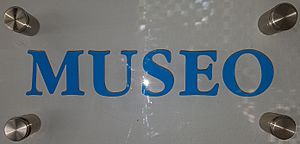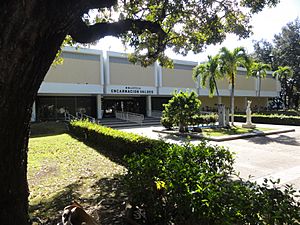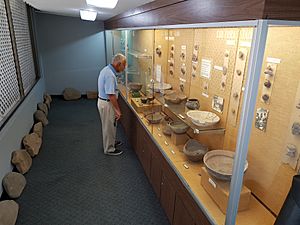Museo de Arqueología de la Pontificia Universidad Católica de Puerto Rico facts for kids
| Museo de Arqueología de la Pontificia Universidad Católica de Puerto Rico | |

Plaque at the entrance to the museum
|
|

Building that houses the museum
|
|
| Lua error in Module:Location_map at line 420: attempt to index field 'wikibase' (a nil value). | |
| Former name | Museo Arqueológico |
|---|---|
| Established | 6 December 1972 20 November 1980 (Re-established) |
| Location | Biblioteca Encarnación Valdés, PUCPR, Avenida Las Américas Ponce, Puerto Rico |
| Type | Archaeology museum |
| Key holdings | Viví Archaeological Site, Bo. Viví Arriba, Utuado, El Bronce Archaeological Site, Bo. Portugués, Ponce, Canas Archaeological Site, Bo. Canas, Ponce |
| Collections | Taino, Pre-Taino, Igneri, El Bronce |
| Collection size | 10,000+ |
| Visitors | 12,000 |
| Founder | Dr. Enrique Laguerre. Co-founders: Antonio Matos Marques, and Francisco J. Carreras |
| Historian | Luis A. Rodriguez Gracia |
| Owner | Pontifical Catholic University of Puerto Rico |
| Public transit access | SITRAS, Parada Museo de Arte |
| Nearest parking | Street parking |
The Museum of Archaeology of the Pontifical Catholic University of Puerto Rico (also known as Museo de Arqueología de la Pontificia Universidad Católica de Puerto Rico) is a special place in Ponce, Puerto Rico. It's a museum that focuses on archaeology, which is the study of human history through digging up old things. This museum is part of the Pontifical Catholic University of Puerto Rico (PUCPR) and is located inside the university's main library, the Biblioteca Encarnación Valdés.
The museum has a huge collection of over 10,000 artifacts. These are ancient objects from the past civilizations of Puerto Rico. You can see items from the Igneri, Pre-Taíno, and Taíno cultures. While many amazing pieces are on display, the museum also keeps many other artifacts safe in storage because there isn't enough space to show everything at once.
Contents
History of the Museum
The idea for this museum started in 1971. At that time, Dr. Enrique Laguerre, who was in charge of Hispanic Studies at the university, wanted to create a program about Puerto Rican history and culture. This led to the first archaeology course at the university, and soon, the idea of having a museum to show off ancient finds began to grow.
One of the first mentions of the museum was in a 1973 publication. It described the museum as a room with glass cases, maps, and ancient tools and remains from the Igneris and Taino cultures of Puerto Rico. To help teach more about archaeology, the university invited Dr. Ricardo Alegría, a famous archaeologist, to teach a course in 1973–74. After he left, Professor Juan Manuel Ledesma Criado continued teaching the course. With the help of many people, including Mela Pons de Alegría, Ricardo Alegría, Juan Gonzalez, Luis A. Rodriguez Gracia, and various donors, Dr. Enrique Laguerre's dream of opening the museum came true.
During the 1970s, the museum gathered many collections. These included pieces from the Instituto de Cultura Puertorriqueña (Puerto Rican Culture Institute), items from Mr. Herman Ferre's private collection, and even wooden statues called Santos from Dr. Luis F. Sala. The Sociedad Guaynia de Arqueología e Historia (Guaynia Archaeology and History Society) also donated archaeological discoveries. For several years, Professor Juan Manuel Ledesma Criado oversaw the museum.
Moving and Reopening
Unfortunately, the university grew very quickly, and the space where the museum was located was needed for classrooms. So, the museum had to close down. The archaeological items were put into storage, and the exhibits were moved under the care of the university library.
To keep the museum alive, Antonio Matos, the university librarian, decided to create two large glass display areas within the library. This made the museum a part of the library itself. The university president, Francisco Carreras, agreed and even provided money for the project. Around this time, an ancient batey (a ceremonial ball court used by indigenous people) was found in the mountain town of Utuado. With the president's approval, this batey was brought to the university grounds next to the library and became part of the museum's outdoor display.
The museum's collection grew even more with donations from Herman Ferre, the brother of a former governor of Puerto Rico. These new items came from the Cañas archaeological site. Antonio Blasini also donated realistic copies of various indigenous pieces. With these new additions and the completion of the display cases, the museum officially reopened on November 20, 1980. It has been supervised by head librarian Antonio Matos Vazquez ever since. Later, the museum's display area was made even bigger, using spaces under the library staircases. Two models were created there: one shows indigenous people playing a ball game, and the other shows a burial inside a cave.
Caring for the Collection
In the mid-1980s, Mr. Luis A. Rodriguez Gracia and Dr. Luis E. Diaz Hernandez took on the big job of cleaning, identifying, and organizing all the museum's items that were not on display. Their hard work led to several reports, including a very detailed one published in 1987. This report listed every item in the collections, who identified it, where it was found, and where it is now at the university. It also explained how they cared for the items. The items are sorted into six groups: ceramics, bones, shells, soil samples, samples for Carbon-14 dating (a way to find out how old something is), and rocks.
Important Moments
In 2010, Luis A. Rodriguez Gracia, who had been the museum's curator and historian for over 30 years, wrote a short book about the museum's history and its collection. Here are some interesting facts from his report:
- Prof. Mela Pons de Alegría designed the first display cases and how the museum was set up in 1971.
- Prof. Ana Basso Bruno from the Fine Arts Department decorated the walls with indigenous designs.
- Dr. Ricardo Alegría brought the first pieces to the museum, including a human burial.
- The first museum had decorated amulets (called cemies in Spanish), axes, necklaces, and different types of pottery.
- The first artifacts included items from very old periods like the Lithic, Petaloid, Saladoid, Elenoid, and Capa periods.
- The museum played a big role in inspiring students to form the Sociedad Guaynia de Arqueología e Historia (Guaynia Archaeology and History Society), which still exists today.
- The museum hosted important meetings and workshops for archaeologists from all over the Caribbean.
- The Fundación Puertorriqueña de las Humanidades (Puerto Rican Humanities Foundation) gave a lot of financial support, and the Puerto Rico Office of Historic Preservation helped with logistics.
Museum Collection
The museum's main exhibition is located on the first floor of the university's Biblioteca Encarnación Valdés. Some of the important collections you can see include:
- Archaeological pieces given by the Instituto de Cultura Puertorriqueña.
- Mr. Herman Ferre's private collection from the Barrio Canas area, which includes pottery styles from the Hacienda Grande and Hacienda Cuevas periods.
- Dr. Luis F. Sala's private collection of wooden Santos (carved religious figures).
- Items from the Sociedad Guaynía de Arqueología e Historia Inc.
- Don Antonio Blasini's private collection, which has copies of indigenous pieces.
Among the museum's most important items are:
- About 2,500 everyday objects from the Igneri culture.
- Nearly 4,000 pieces of Taíno pottery.
- Almost 1,000 glass fragments and containers from different times.
- Over 400 Taíno carvings and symbols.
- A collection of Taíno burials.
Fieldwork and Discoveries
The museum has been involved in fieldwork for more than 40 years. Fieldwork means going out to archaeological sites to dig and find ancient objects. The museum has conducted excavations and other fieldwork at these important archaeological sites:
- El Bronce, Ponce: Dr. Gary Vescelius led work here in 1987.
- Barrio Canas, Ponce: Fieldwork took place around 1985.
- Barrio Vivi Arriba, Utuado: Fieldwork also happened around 1985.
Images for kids




